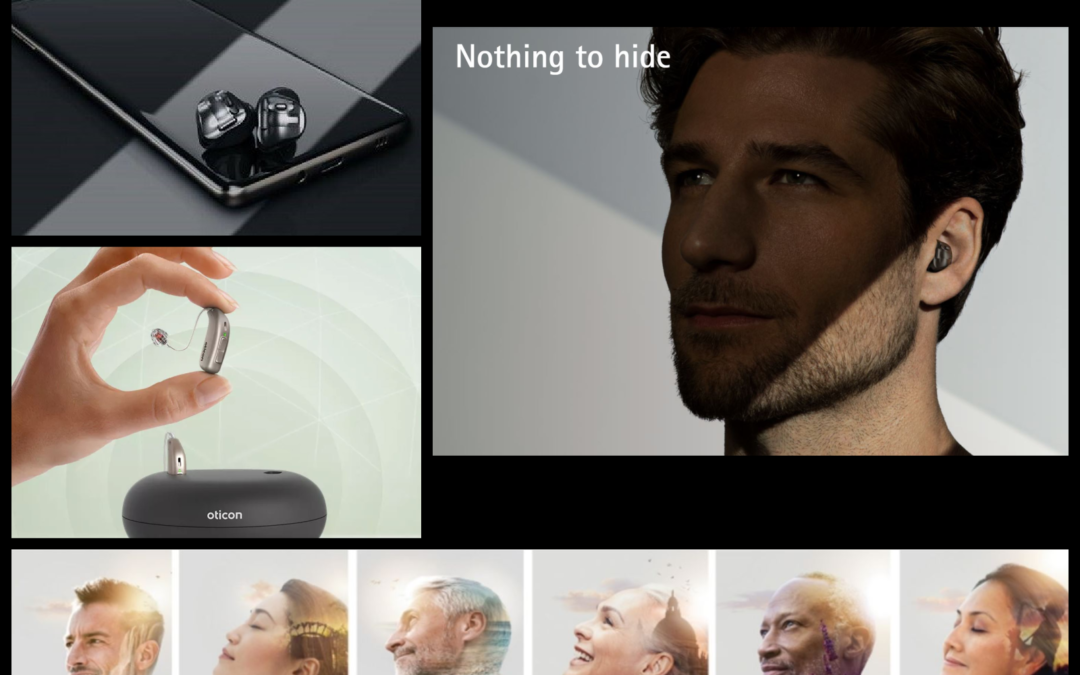
by Paula Rivers Au.D | Mar 1, 2021 | News
The new year is already going strong, and to help you have more good things this year, we’re excited to tell you about the latest hearing technology we’ve added to our collection: the Oticon More™, the Phonak Paradise, and Phonak Virto Black. These three new hearing technology options are at the top of our 2021 list of hearing technology for better connections.
Oticon More™
The Oticon More™ was released at the beginning of the year and already shows promise. Since there is a strong link between hearing loss left untreated and a heightened risk of dementia, it’s clear that Oticon has used this knowledge to design a better device. This hearing aid carries 30% more sound to the brain, which means your speech understanding can increase as much as 15%. It also means reduced listening effort, making it easier for you to remember what is said. It has even been shown to reduce tinnitus for some wearers.
These hearing aids are well-connected to today’s technology. You can use them to stream directly from your smartphone or your TV (it comes with an adapter, so your TV doesn’t even have to be a specific type). You can also make hands-free calls through your smartphone.
Maintenance on this device is very user-friendly. It has its own app so you can discreetly adjust the controls on your hearing aids. It also has its own charger that gives you a full 24 hours of life, with an additional 6 hours using the 30-min quick charge feature.
Phonak Audéo™ Paradise
Phonak also understands that better speech understanding is key to designing effective hearing technology for better connections with its new Phonak Audéo™ Paradise. This device focuses on delivering crisper and more natural sound with its Speech Enhancer feature, which “boosts soft-level speech” in quiet environments or from a distance. It also uses a personalized approach with its Dynamic Noise Cancellation feature, which allows you to choose the amount of noise to filter when you are in various environments.
Audéo™ is also user-friendly by connecting to prominent technology like smartphones and Bluetooth® (you can even connect two Bluetooth® devices at the same time). In addition, this device has a voice assistant feature you can access with just a tap, allowing you to answer calls, stream music, and more. It also has its app to give you control over your device and connect with other amazing features.
Phonak Virto Marvel Black
In search of a style that looks just like a wireless earbud? We must mention the Virto Black. This fully connected, in-the-ear (ITE) hearing aid combines Marvel hearing technology with the style of a modern hearable. This 2020 “Best of CES” has a customized fit for your individual ears, a clear sound, connects to all your devices, and has a smart app that gives you quick, personalized, fine-tuning options.
At RK, we are always looking ahead to sharing more advancements in technology, and more ways to serve you better. Check our “Technology” page for more information on the latest technology at RK Audiology. Then check out our 3-minute online hearing test and schedule an appointment today!

by Paula Rivers Au.D | Dec 30, 2020 | News
Neuroscience is looking at sensory substitution to change the lives of people with varying levels of hearing loss. As we move into a new year, we are looking forward to how those with hearing loss might find other ways to receive information.
We’ve discovered how music can have a healing effect on the body, thanks to the interaction between the many parts of the ear and the brain. So, what happens if the part of the brain set aside for hearing was no longer used because someone has hearing loss?
Sensory Substitution and Reorganizing the Brain
We’ve already noted how the brain can reorganize and reassign areas of the brain from functions such as hearing to other functions such as vision or touch. This research is now being used to help those who are deaf or hard of hearing with a technique called sensory substitution. This technique gets around the loss of one sense, such as hearing, “by feeding its information through another channel, such as touch.”
This is not new. Sign language uses the hands to communicate, create shapes and movements – patterns – that provide input through our sense of sight. This communication method can even incorporate the sense of touch by having a person who is both deaf and blind use their hands to follow the patterns of the signer.
Now, neuroscientists have developed a new kind of technology, a vest loaded with multiple sensors along the torso that transmits information through the body to the brain using a set of spatiotemporal patterns that vibrate and ripple along the skin. These patterns can correspond to varying kinds of input, but they have mostly been used so far to communicate words and ideas, much like sign language does. If someone speaks to a deaf person wearing a vest, the sensors would translate the spoken words to patterns, and those patterns would communicate the information to the deaf person.
The best part about this technique is that it is non-invasive. Even better, this technology would be a fraction of the cost of surgical options such as cochlear implants, making it available to people worldwide.
Using Patterns to Communicate
Much like sign language, the vest uses patterns to communicate information. In this case, a set of sensors are placed along the torso on the back part of the vest. These sensors have been calibrated to make a kind of pattern that is spatiotemporal. This means that instead of each sensor vibrating separately, or sets of sensors vibrating simultaneously, the sensors are instead calibrated to vibrate in a movement, like a ripple or a wave that moves across the skin in various directions. They found this to be far more effective in transmitting the information than the static vibrations, either singular or in groups.
These patterns would work much like braille, which is to say that a person would come to subconsciously relate certain patterns with certain words without having to think about it. Early tests with one deaf person have already shown this to be the case, and the creators of the vest, David Eagleman and Scott Novice, are looking forward to more trials.
Plug-and-Play Organs and Our Limited Sensory Perception
To get a better idea of how this technique is viable, it helps to have an understanding of our sense organs. Sense organs shape the way we perceive the world. They receive and transmit input to the brain, where the input is processed into information that we use to learn, make decisions, and experience life. They are how we know and understand our surrounding reality. However, this reality is not as objective as we think it is.
The first thing to understand about sensory perception is that the organs we most connect to the senses – ears, eyes, nose, tongue, and skin – are incredibly limited in the data our brains receive from them. We cannot see the many types of light, electromagnetic, and radio waves that pass through the air. Some animals can see these but not others, such as snakes that can see some infrared light waves or honeybees that are able to see in the ultraviolet range. Our other sense organs are likewise limited; imagine having the nose of a bloodhound and being able to know there’s a cat somewhere a couple of blocks away or where another person has been all day by taking a deep whiff of the bottoms of their shoes.
So, when a person loses the function of one of these organs, it’s much easier to find a substitute for delivering certain kinds of input to the brain than you might think. They are more like plug-and-play devices for computers and video games, which can be replaced with another device as needed. Some of these devices need a software download, teaching the computer how to work with the new device. This is similar to how these plug-and-play sense organs work. If one of them stops functioning, the brain can reassign that area to something else, like heightening one’s vision or learning to work with this vest through touch.
In addition, sensory substitution, these neuroscientists believe, can eventually become sensory addition, adding new perceptions to our sensory experience. This can help with rehabilitative and assistive processes, as well as other forms of neural plasticity research and technology. That’s information worth sharing with everyone.
For more information on how hearing and the brain are related, follow our blog, follow the research, or make an appointment today. You can get started with understanding your own hearing in a socially distanced way by trying out our new 3-minute online hearing test. Here’s to a Happy New Year! Bring on 2021!!
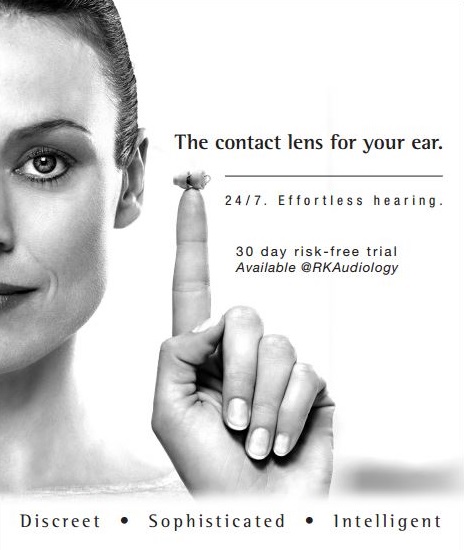
by Paula Rivers Au.D | Dec 9, 2020 | News
Invisible Hearing Aids Get a Boost from Phonak with the Lyric4
Phonak Lyric™ invisible hearing aids are best known for their invisibility, comfort, and convenience. Now they’re creating a brand new gold standard with the launch of Lyric4.
If you are looking to level up your hearing aids, Phonak recently released the new Lyric4, and it is better than ever. It was already a 100% invisible hearing device, designed to be worn comfortably 24/7 for months at a time, stands up to showering and challenging environments, and is controlled with the SoundLync™ tool. Here are its newest features:
Features:
- What was already an invisible and comfortable device has been decreased in size by 0.3mm. Test subjects noted that this new model is “significantly more comfortable than the previous generation.”
- The smaller size has made this device more viable for people with smaller ear canals so that they can enjoy the convenience of having a 24/7 invisible hearing aid.
- The LyricTM design uses the ear canal, rather than an outside device, to capture and process sound for a more natural hearing experience. The new Lyric4 has a more effective design for collecting debris and cerumen that interfere with the receiver. This allows it to prevent clogging between maintenance and fittings.
As you can see, Phonak has taken the Lyric™ invisible hearing aid to the next level. Check out their site for more information, or schedule an appointment today!
Bonus Tip: If you feel that your hearing has changed and/or if you are noticing more difficulties hearing in this day of masks and social distancing, prior to scheduling an appointment, check your hearing now at https://rkaudiology.com/online-hearing-test/
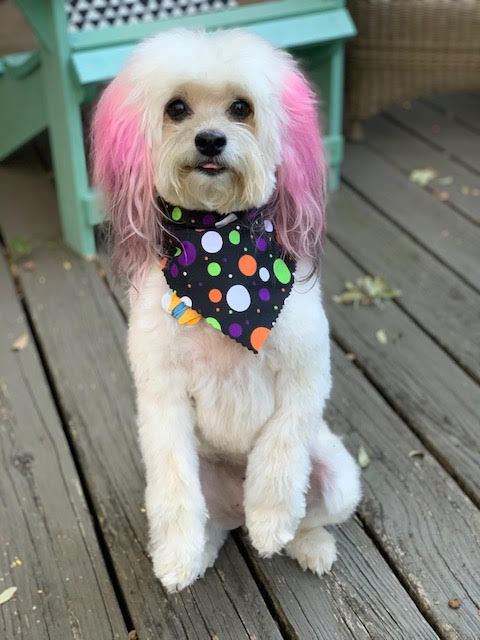
by Paula Rivers Au.D | Oct 1, 2020 | News
If you have a dog, you want them to be as healthy as you are. Special diets, exercise, and regular trips to the vet are all important, but what about their ears? Just like humans, the state of your dog’s ears affects their overall health and can be an indicator of other health issues. Likewise, methods of safe ear cleaning for dogs are often best left to professionals, but you can still do some at-home maintenance with RK Audiology’s help. Whether those ears stand up or droop, these safe cleaning tips will help make sure man’s best friend has healthy ears and hearing.
Different Breeds Need Different Types of Care
Safe ear cleaning for dogs starts with knowing each dog will have different ear care needs. Depending on who you ask, there are between 200 and 350 different breeds worldwide. Each breed comes with its own unique anatomy, as well as health issues that can affect, or be affected by, ear health. Talking to your veterinarian and dog breeder about breed-specific concerns will make you better able to make good decisions for Fido.
Know When It’s Time for a Cleaning
Even with breed-specific concerns, there are still ways to know whether it’s time for at-home treatment or time for a visit to the vet. Certain breeds need more frequent cleanings than others, such as dogs that spend a lot of time in the water. There are, however, some general rules. Dogs with ears that hang down tend to trap moisture and dirt, while dogs with ears that are open or stand up are prone to infections.
You can also tell a lot by spot inspection. Before you can do one, you will need to know what a healthy ear looks like. The best time to learn this is with your vet but, overall, the inside of dogs’ ears should look pink rather than red. Redness is a sign of inflammation and possible infection. They should also leave no odor. If you do notice a slight odor, or if your best friend is shaking their head or scratching their ears a lot, the American Kennel Club suggests it’s time for a cleaning. If the ear looks red and inflamed or smells yeasty, however, head to the vet.
How to Safely Clean Your Dog’s Ears
If it’s time for a home cleaning, remember that safe ear cleaning for dogs is similar to safe ear cleaning for humans. That means this is not the time to break out the cotton swabs. Nor should you go directly for a bottle of alcohol or hydrogen peroxide. Because of the structure of a dog’s ear, these items can irritate the ear canal. Furthermore, they don’t actually remove all the wax, dirt, and other irritants, and you may possibly damage the ear trying.
Instead of using items that can cause or worsen an infection, try cleaning drops specially formulated for dogs. These drops dissolve ear wax, and some have antifungal or antibacterial properties. We recommend Earwax PETTM
Here are simple steps for using this to effectively clean your dog’s ears:
- Lay the dog on their side and gently wipe away any debris from around the outer ear with a cotton ball or facial tissue. This can also be done with the dog in a normal standing position.
- For large dogs (greater than 35 pounds), slowly place 1 full dropper into the ear canal.
For small dogs (less than 35 pounds), slowly place ½ dropper into the ear canal.
- Gently massage the base of the ear for several minutes.
- Keep the dog still for 5-15 minutes to allow the wax and debris to dissolve.
- Allow the dog to shake its head as needed to remove excess fluid. (This is why we recommend doing this outside!)
- Dry outer ear canal with a clean cotton ball or clean tissue.
- Repeat immediately if the ear canal is not visibly clean.
- Treat ears every month or as directed by your veterinarian.
As you and your veterinarian decide what is the best way to treat your dog, please make sure to always be gentle. Dog ears are easily damaged when proper care is not taken. If you have questions on safe ear cleaning for dogs, contact your vet or the American Kennel Club. You can also contact RK Audiology for more resources and to schedule your next appointment. You are, after all, your dog’s best friend.
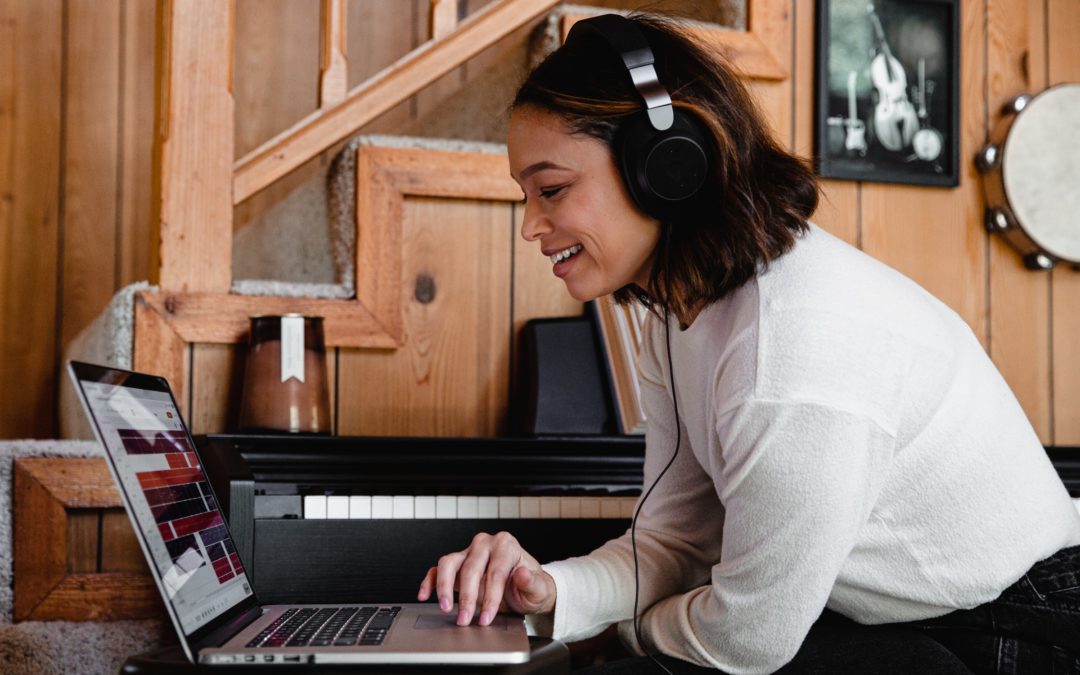
by Paula Rivers Au.D | Sep 1, 2020 | News
RK’s Top 5 Remote Hearing Care Hacks For These Changing Times
As we continue to weather these changing times, RK Audiology wants to make sure that you have the best access to care in our office and your home. These top remote hearing care hacks can help you stay on top of your hearing health as you navigate our current landscape.
1. Elephant Ear Washer System
Safer ear cleaning at home has never been more straightforward with the first item on our top remote hearing care list: the Elephant Ear Washer System. This all-in-one system provides a safe alternative to cotton swabs with a nozzle that squirts water into the ear canal, which can then be drained over a sink, in the shower, or into an ear basin. Remember, for truly safe earwax removal, you should always consult your audiologist, who can teach you how to use your own Elephant Ear Washer System safely. You can find this practical device in the RK Shop: https://shop.rkaudiology.com/s/shop
2. Home-care Otoscopes
An otoscope is a tool used to view the outer ear, ear canal, and eardrum. Having one of these handy in your home can serve as an early screening process that saves you time and money. By providing clear views of your ears, which can then be sent to our office, an otoscope helps us know when you need to come in for an in-person appointment. As always, review with your audiologist how to use any instrument that goes near your ears safely. We recommend the Bebird Otoscope: https://www.bebirdmall.com/
3. Online Hearing Tests
Our virtual hearing test is one of our newest RK website features, and it’s quickly becoming a favorite telehealth option. By going to https://rkaudiology.com/hearing-test-online/, you can test your hearing remotely. You can keep track of your hearing by checking it at regular intervals (we recommend every 3 to 6 months, or sooner if you notice a change in hearing). Contact us with questions or schedule a time to come in and see us for a comprehensive audiological evaluation or your annual hearing test: https://rkaudiology.com
4. Rechargeable hearing aids
Rechargeable hearing aids have improved so much in recent years that they will likely soon replace the disposable battery-powered hearing aids altogether. That’s excellent news for hearing aid wearers, as this eliminates the need to change batteries multiple times per day, cutting down on time, bother, and overall cost. If you are used to one-charge-per-day as you do with a mobile device, the new lithium-ion batteries last all day, making an overnight charge easy and convenient. Ask your audiologist if rechargeable batteries are available for your current hearing instruments and/or if it is time for an upgrade to new hearing technology.
5. Remote Care For Your Hearing Tech
You may be wondering if all these remote hearing care hacks are going to require time-consuming and costly upkeep. Fortunately, RK Audiology has you covered. We have curbside dropoff and pickup, as well as a 24/7 dropbox available. We will service, repair, and clean your hearing tech for you! Take a look at our services here: https://rkaudiology.com/our-services/
For our DIY-ers, you can take care of your hearing aids easily. Watch this tutorial for more information: https://rkaudiology.com/hearing-aid-care/
The world is quickly changing, and RK Audiology knows how to keep your hearing safe and healthy. Try some of the items on our remote care hearing list to make a smooth transition, or set up an appointment for more information today.
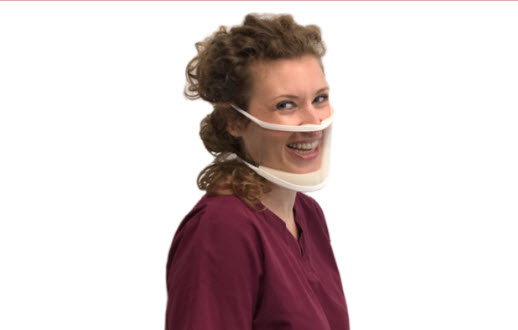
by Paula Rivers Au.D | Jun 3, 2020 | News
As we move into a new era, the question of how to keep ourselves safe from COVID-19 and other pandemics is evolving from immediate control practices to how things should look moving forward. RK Audiology cares about our client’s safety beyond quarantine as much as we care about the current situation. To accommodate you better, we have initiated some new services to help flatten the curve now and to help prevent future outbreaks.
New Safety Measures
Curbside Audiology
You no longer have to come into our office to drop off or hearing aid pick up repairs. Simply call our office ahead of time and we will meet you at the curb, saving you time and assisting you with social distancing.
Telehealth Appts
Many of our services are now available via phone or video conferencing. These appointments are all HIPAA compliant and easy to schedule. Get more information here:
https://rkaudiology.com/telehealth/
Online shop
To lessen contact, we’ve put some of our best products online in a new shop. You can find items such as:
- Ear care and cleaning products
- Supplies for the care and maintenance of your hearing aids
- Cleansing wipes to keep your devices clean
With free shipping, this new store will make purchasing your regular ear and device care supplies convenient and cost-effective. You can even find gift cards for you and your loved ones.
https://shop.rkaudiology.com/
Safety Beyond Quarantine Means Changing Our Habits
Once we are all moving forward again, it’s important to remember that we can help prevent future outbreaks by continuing to use some of the new routines we’ve developed over the last few months. There are simple things you can do to ensure your safety and others’ safety beyond quarantine:
- Wash your hands frequently – We come in contact with germs and dirt in every part of our lives. Washing your hands with soap and water for at least 20 seconds (Humming the birthday song twice is a good indicator!), helps keep your hands clean and disinfected.
- Sneeze and cough into your elbow or shoulder – Covering your mouth whenever you cough or sneeze is always a good practice. After the face masks come off, make sure to sneeze or cough into your elbow or shoulder.
- Stay home if you’re sick – We’re learning new things about work/life balance during this process, and one takeaway should be to stay home when you feel an illness coming on. It helps others stay healthy and helps you get better more quickly.
- Personal self-awareness – Once we’re all able to be in closer contact again, it is still a good idea to develop personal awareness of yourself and the people and things around you. Keeping surfaces disinfected and observing personal space can go a long way toward keeping us all healthy.
We will continue to find new and convenient ways to help our clients adapt during this time and increase everyone’s safety beyond quarantine. Check out our new shop or book an appointment today!
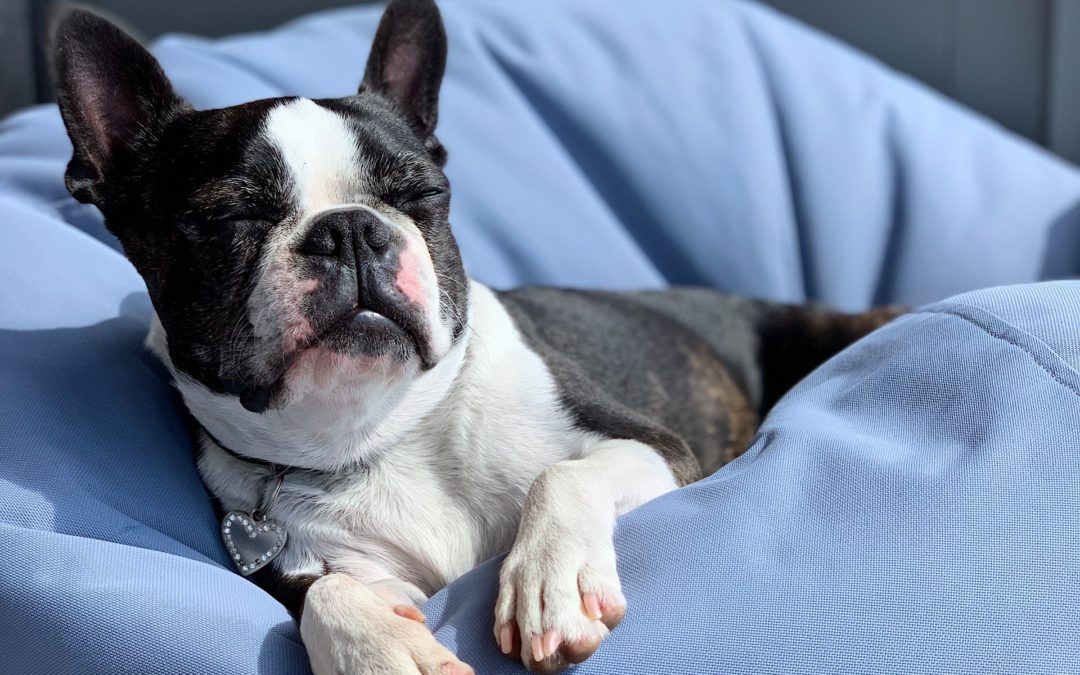
by Paula Rivers Au.D | Apr 1, 2020 | News
Between our heavily populated cities and our commuter culture, finding some peace and quiet to sleep can be a challenge – even in your own home. If you’re experiencing problems related to sleep in noisy environments, you’re not alone. While healthy nutrition and exercise practices (as well as that perfect pillow) can help sleep overall, RK Audiology has some suggestions for getting a peaceful night’s sleep in environments that aren’t so peaceful.
Sound Machines
Sound machine technology has vastly improved over time. You can even find apps that offer a variety of features, from mixing your own soundtrack to offering pre-bedtime meditations to put you in the right mindset.
Our app recommendation: White Noise Pro (for iOS & Android)
Foam Earplugs
Perhaps the simplest way to catch some Z’s when you’re at home or abroad is basic foam earplugs. These are inexpensive, widely available in most drug stores, and easy to take with you anywhere. A pair fits effortlessly in an overnight bag, the pocket of a handbag or backpack, or even your own back pocket.
Custom Earplugs
If you’re looking to level up on earplugs, you can’t go wrong with a custom-fitted pair. These upgrades on basic foam earplugs are form-fitting, made of soft material, and offer greater comfort when sleeping.
Check out our favorite models: https://rkaudiology.com/custom-fit/
Earbuds with Audio Stimulation
One of the things we recommend to our clients with tinnitus is auditory stimulation. Streaming podcasts, or playing music or an audiobook before bed does wonders to help people fall asleep.
Sleep in Noisy Environments Resources
There are many resources to help you find that elusive undisturbed rest:
Finding ways to prevent pesky noises from ruining your slumber is easier than ever, whether you’re on that red-eye for a job, or just want to block out the construction down the street (or hallway). For more information on better sleep in noisy environments, contact us or schedule an appointment today!
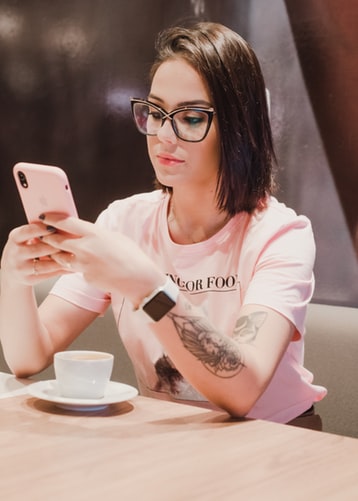
by Paula Rivers Au.D | Mar 1, 2020 | News
Hearing accessibility is getting the boost it deserves with new Apple Watch features. Apple’s hearing initiative is making it easier than ever for those with hearing issues to manage solutions to everyday problems. It’s as simple as the press of a button.
Apple’s Hearing Health Study
Early in 2019, Apple announced a new health initiative that would tackle some major issues involving heart health, women’s health, and hearing health. They have partnered with organizations like the American Heart Association and the World Health Organization to create studies through their Research app, which they believe “democratizes how medical research is conducted.” Late last year, they rolled out a number of new features on some of their most popular devices.
Hearing Accessibility with the Apple Watch
The Apple Watch® has some impressive features in store for those who need better hearing accessibility. These features utilize tactile response as well as visual alerts to help those with hearing issues. When paired with the iPhone®, they are revolutionizing hearing accessibility.
- Noise App: Track decibel levels in your environment to make good decisions about your hearing health and protect your hearing.
- Taptic Engine: Receive tactile sensations to warn you of upcoming announcements. A simple “tap” alerts you so you never miss an important message.
- Scribble: Write a response by scribbling simple text on the display.
- Mono Audio: Allows you to adjust balance in Bluetooth headphones to compensate for hearing issues in one ear or the other.
Hearing Accessibility with iPhone®
These additional iPhone® apps and features add to Apple’s accessibility initiative.
- Live Listen: Works with your hearing in noise devices to focus on conversations in loud places.
- Siri: Set up Siri to type instead of speak commands and ask questions.
- Facetime: Long used by deaf and hard of hearing people, this app comes on all Mac and Apple devices.
- iMessage: Unlimited messages in this text-based app help keep you connected with everyone.
- Closed Caption: Purchase CC-supported videos in the iTunes Store or iTunes U and watch on your phone.
Thanks to the Apple Watch® and iPhone®, hearing accessibility is becoming better than ever. To learn more about how to integrate Apple products to your lifestyle, schedule an appointment with RK Audiology today!

by Paula Rivers Au.D | Feb 1, 2020 | News
United States presidents have had to face many challenges over the centuries: war, social upheaval, illness, and injury. It’s no surprise, then, that the fact that some presidents had various hearing loss issues rarely makes it into our textbooks. However, we could learn a lot from the history of presidents and hearing loss. It shows us that everyone – even those in the highest office in the land – deal with everyday health issues and find ways to overcome hardship.
An Early History of Presidents and Hearing Loss
The United States, like many countries, was forged from the ashes of war. So, our story begins with our very first president, George Washington, who emerged from the Revolutionary War with pronounced hearing loss. The constant barrage of cannon fire, musket and pistol fire, and other wartime environments led to hearing problems after his military service that he would carry with him for the rest of his life.
War has not been the only cause of hearing problems in our highest office. Thomas Jefferson, our third president, had hearing loss, likely due to his exposure to hunting rifle fire. It caused him much difficulty, as he noted in one of his letters: “My hearing is distinct in particular conversation, but confused when several voices cross each other, which unfits me for the society of the table.” Other presidents throughout history have also experienced hearing loss due to gunfire, including Ronald Reagan and Bill Clinton.
As with many people, some presidents experienced hearing loss due to natural factors such as age and illness. This was often after leaving office, as in the case of President Teddy Roosevelt, who lost hearing in one ear after having an abscess removed. President Herbert Hoover had age-related hearing loss after leaving office. It would make him the first president to use a device we now take for granted.
Hearing Aids in the Oval Office and Beyond
Electronic hearing aids had been around since the late 19th century, but it wasn’t until long after our 31st president, Herbert Hoover left office in 1933 that a president first used a hearing instrument. By then, transistor hearing aids had become common. Hoover used his device to great effect, turning it off when he did not wish to listen to particular speeches.
By the 1980s, digital hearing aids had emerged as a superior technology to the past, but the 1970s recession and other factors had created a decline in the industry. It was at this time that Ronald Reagan became the first president to wear hearing aids while still in office. Reagan had experienced hearing loss since 1939, when a .38-caliber pistol was discharged near his right ear while working as an actor on the set of Code of the Secret Service. This is the equivalent of 150-175 dBA (A-weighted decibels), approximately twice as loud as the safety-recommended 85 dBA.
When the news released that the president had begun wearing hearing aids, the media went wild, using this as further evidence to question the aging man’s fitness for office. Reagan turned it around and became an advocate and spokesperson for hearing loss, declaring May “Better Hearing & Speech Month” in 1986. The industry began an upswing.
Bill Clinton was fit with hearing instruments while in office. His history of noise exposure while playing saxophone in a band, in addition to age-related loss, has been attributed to his need for amplification. Clinton is also an advocate, having worked with the Starkey Hearing Foundation (created by the same company to provide Reagan with his hearing aids), alongside his daughter Chelsea and former President George H.W. Bush.
Gaining Respect for the Deaf and Hard-of-Hearing
No history of presidents and hearing loss would be complete without discussing the impact that presidents have had on the rights of those with hearing loss and other physical challenges. Respect has been a hard-fought right for this group of people, going back centuries. While the first deaf school in the world was established in 1760, it would be another century before the United States would have one of our own.
In 1857, President Franklin Pierce signed a piece of legislation establishing the Columbia Institution, a school for deaf and blind children. President Abraham Lincoln signed the charter allowing the school to grant collegiate degrees in 1864. This college would later come to be known as Gallaudet University, the only college to offer undergraduate and graduate programs in a completely American Sign Language (ASL) environment. The university has had many advocates, including President James A. Garfield, who routinely fought with Congress to keep the school funded and open. His last speech sometime before his assassination was a commencement speech for Gallaudet.
Lyndon B. Johnson was another U.S. President to have an impact on the education of deaf and hard-of-hearing people. In 1964, he signed the National Technical Institute for the Deaf Act. This established the first technological college for deaf and hard-of-hearing people seeking STEM careers. NTID, a part of the Rochester Institute of Technology (RIT) campus, has created higher rates of employment among deaf and hard-of-hearing people.
In 1990, disability rights took a leap forward. President George H.W. Bush signed into law the Americans with Disabilities Act (ADA), increasing accessibility for millions of people. Public venues were now required to provide assistive listening options for patrons. He, too, would have hearing loss after leaving office.
The history of presidents and hearing loss shows us that U.S. presidents are just like everyone else. Seeing how they overcome hearing issues can further inspire us to make our own hearing health a priority. Learn more about hearing health by contacting our office. Schedule an appointment today!
Sources:
- Weisman, Steven R. (1983, September 8). REAGAN BEGINS TO WEAR A HEARING AID IN PUBLIC. Retrieved from https://www.nytimes.com/1983/09/08/us/reagan-begins-to-wear-a-hearing-aid-in-public.html
- History of NTID. Retrieved from https://www.ntid.rit.edu/history
- silentgrapevine. (2017, October 9). The World’s First Public Deaf School: Institut National de Jeunes Sourds de Paris. Retrieved from https://silentgrapevine.com/2017/10/the-worlds-first-public-deaf-school-institut-national-de-jeunes-sourds-de-paris.html
- Karl. (2013, August 27). Looking Back 30 Years to 1983: President Reagan Gets Hearing Aids. Retrieved from https://www.hearingreview.com/inside-hearing/industry-news/looking-back-30-years-to-1983-president-reagan-gets-hearing-aids
- Noise-Induced Hearing Loss Can Affect Anyone—Including Presidents. Retrieved January 15, 2020 from https://www.noisyplanet.nidcd.nih.gov/have-you-heard/noise-induced-hearing-loss-affect-anyone-even-presidents
- Historical Timeline. Retrieved January 15, 2020 from https://www.gallaudet.edu/about/history-and-traditions/historical-timeline
- 10 US Presidents with Hearing Loss. (2018, April 17). Retrieved from https://www.gallaudet.edu/about/history-and-traditions/historical-timeline

by Paula Rivers Au.D | Jan 1, 2020 | News
It’s a brand new year, time to think about goals we want to accomplish and how we will succeed with our dreams. As a final part of our “Spreading Good Cheer” series, here are a few inspiring stories about people who didn’t let their hearing loss keep them from achieving their dreams.
Lemons to Lemonade
Some think of hearing loss as a deficiency, but this family has found a way to create something exciting and new (or old, in fact) while giving back to their community:
4-year-old with hearing disorder is CEO of popular lemonade stand
Teens with Dreams
These two stories feature teens who have found ways to make their dreams come true with the help of Oticon’s “Focus on People Awards” which “aim to support ‘exceptional people with hearing loss’” and “change perceptions of what it means to have a hearing loss.”
Marana grad finalist for hearing loss award
Local aspiring chef doesn’t let hearing loss slow him down. Now he’s up for an award
However we choose to accomplish our dreams, it helps to know that something like hearing loss doesn’t have to become a barrier. Of course, the best way to keep hearing loss from slowing us down is to keep our hearing healthy with good nutrition, hearing protection, and regular checks and cleanings. Let RK Audiology help you by scheduling an appointment with us today!
If you missed any of the posts in this series and others, you can always check them out on our blog. Happy New Year!










